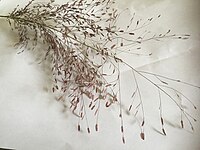Olmeca is a genus of Mesoamerican bamboo in the grass family.

Poa flabellata, commonly known as tussac grass or just tussac, is a tussock grass native to southern South America, the Falkland Islands, South Georgia and other islands in the South Atlantic. There are also two isolated records from the herbarium at the French Muséum national d'histoire naturelle for the Île Amsterdam in the Indian Ocean.

Chloridoideae is one of the largest subfamilies of grasses, with roughly 150 genera and 1,600 species, mainly found in arid tropical or subtropical grasslands. Within the PACMAD clade, their sister group is the Danthonioideae. The subfamily includes widespread weeds such as Bermuda grass or goosegrass, but also millet species grown in some tropical regions, namely finger millet and teff.

Centotheceae is a small tribe of grasses with six species in two genera, distributed in Africa and Asia. It belongs to a basal lineage in subfamily Panicoideae, sometimes referred to as "centothecoid clade". Unlike many other clades in the subfamily Panicoideae, they use the C3 photosynthetic pathway.

Puelia is a genus of African grasses, the only genus in the tribe Atractocarpeae. It belongs to the subfamily Puelioideae, one of the early-diverging lineages in the grasses, but used to be considered a bamboo genus.
Oplismenopsis is a genus of South American plants in the grass family. The only known species is Oplismenopsis najada, native to southern Brazil, Uruguay, and northeastern Argentina.
Micraira is the only genus of tribe Micraireae in the grass family, native to Australia.

Paniceae is a large tribe of the subfamily Panicoideae in the grasses (Poaceae), the only in the monotypic supertribe Panicodae. It includes roughly 1,500 species in 84 genera, primarily found in tropical and subtropical regions of the world. Paniceae includes species using either of the C4 and C3 photosynthetic pathways, as well as presumably intermediate species. Most of the millets are members of tribe Paniceae.

Bromus pubescens, the hairy woodland brome or hairy wood chess, is a grass species found across much of the eastern and central United States, as well as in Arizona, Québec and Ontario.

Calamagrostis lapponica, the Lappland reedgrass, is a grass species native to colder parts of the Northern Hemisphere. It has been reported from Scandinavia, Russia, Greenland, Alaska, and every Canadian province and territory except the Maritime Provinces.
Phaenospermatae is a tribe of grasses, subfamily Pooideae, containing a single genus, Phaenosperma. The tribe previously included several other genera, which are now placed in a separate tribe, Duthieeae.
Altoparadisium is a genus of bunchgrass plants in the grass family. The species are native to Brazil and Bolivia in South America.

Micrairoideae is a subfamily of the grass family Poaceae, distributed in tropical and subtropical regions. Within the PACMAD clade, it is sister to subfamily Arundinoideae.

Triraphideae is a small tribe of tropical grasses, containing 14 species in three genera. Like most of the subfamily Chloridoideae, species in the tribe use the C4 photosynthetic pathway.

Zoysieae is a tribe of grasses in subfamily Chloridoideae, with around 250 species in four genera. All species use the C4 photosynthetic pathway.

Eriachneae is a tribe of grasses in subfamily Micrairoideae, with 50 species in two genera. Species in the tribe use the C4 photosynthetic pathway and are distributed mainly in Australasia, reaching into Asia and Micronesia.

Arundinelleae is a tribe of grasses with roughly 90 species in three genera, mainly distributed in tropical and subtropical areas. The tribe's sister group are the Andropogoneae, with which they are classified in supertribe Andropogonodae. All species in this tribe use C4 carbon fixation.
Steyermarkochloeae is a tribe of the Panicoideae subfamily in the grasses (Poaceae), native to tropical South America. There are only two species in two genera, Arundoclaytonia and Steyermarkochloa. The tribe probably belongs to a basal lineage within the subfamily. Species in this tribe use the C3 photosynthetic pathway.

Tristachyideae is a tribe of the Panicoideae subfamily in the grasses (Poaceae), native to tropical and subtropical regions of Africa, Asia, and South America. There are around 70 species in eight genera. The tribe belongs to a basal lineage within the subfamily, and its genera were previously placed in tribes Arundinelleae or Paniceae, subfamily Arundinoideae, or the now-obsolete subfamily Centothecoideae. Species in this tribe use the C4 photosynthetic pathway.
Cenchrus elegans is a species of plants in the grass family. It is found in Malesia.














